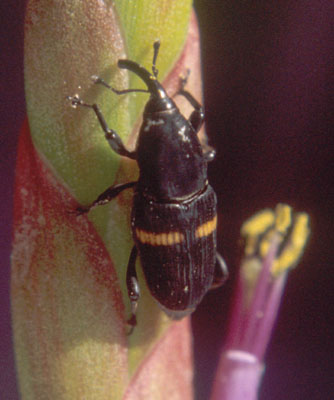|
|
|
In production of Dracaena fragrans ‘Massangeana’, commonly called the corn plant, nursery personnel may notice piles of sawdust-like material at the base of cane sections. |
|
BEETLES |
|
|
|
In production of Dracaena fragrans ‘Massangeana’, commonly called the corn plant, nursery personnel may notice piles of sawdust-like material at the base of cane sections. |
|
|
|
These sawdust-like deposits actually are piles formed by fallen tendrils of fecal material and wood borings which extend from the sides of cane infested by a small beetle. |
|
|
|
This pest is an ambrosia beetle and forms many tunnels within infested cane. Cane may be obtained that already contains an initial infestation which can rapidly spread to uninfested cane if undetected. |
|
Also, palm seeds may be similarly attacked by this group of beetles. Heavily infested seeds fail to germinate. |
|
|
|
The Florida tortoise beetle, Hemisphaerota cyanea (Say), is a beautiful small beetle that feeds on a variety of native and exotic palms on which it occasionally inflicts damage by its feeding activities. It is our only tortoise beetle that feeds on palms. |
|
Florida bromeliad weevil
|
 Mexican bromeliad weevil
|
|
The Florida bromeliad weevil is an minor pest of ornamental bromeliads. The Mexican bromeliad weevil, Metamasius callizona, which is currently attacking five species of native bromeliads and will likely destroy populations of six additional species of already-threatened or endangered bromeliads if not brought under control. |
|
|
The palmetto weevil is considered a minor pest but is becoming more important because of the damage is inflicts on stressed nursery and transplanted palms. |
| More information on beetles can be viewed at "Insect and Related Pests of Flowers and Foliage Plants". Click here to go there now! |